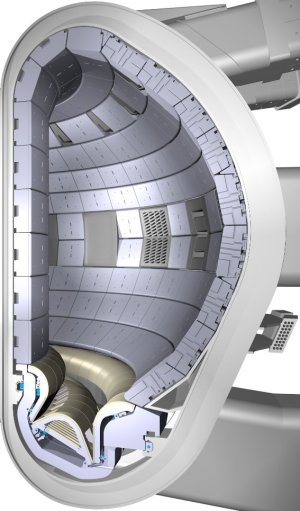The UK firm MG Sanders is developing tungsten tile modules that will soon be installed in the Joint European Torus, where the components will be evaluated for use in the ITER fusion reactor. Ian Warrington explains the challenges of developing a complex technology that can withstand the intense heat of nuclear fusion.

When the ITER fusion reactor is up and running in 2018, its plasma of tritium and deuterium is expected to reach 100 million K, which is hotter than the core of the Sun. One of the main challenges in designing the reactor is how to stop the plasma — contained by powerful magnetic fields — from being contaminated by unwanted materials that evaporate from the inside “first wall” of the torus-shaped vessel (or tokomak) that surrounds the plasma.
Most existing fusion reactors, such as the Joint European Torus (JET) in the UK, use carbon-composite (CFC) tiles for the first wall. Although such tiles can withstand extremely high temperatures, they are not suitable for use throughout ITER because the material tends to absorb tritium, which can weaken the tiles and remove lots of tritium from the plasma.
As a result, CFC tiles in ITER will be reserved for the hottest parts of the first wall — the divertor strike points where the plasma is actually deflected from the wall. Tungsten-coated tiles will be used elsewhere in the divertor, which guides heat and particles around the torus. The main chamber will be clad with beryllium tiles.
The combination of beryllium and tungsten has never been tested in a tokamak and both materials offer benefits and challenges. Tungsten is very resistant to high temperatures (melting at 3695 °C). However, it is a heavy element that ionizes easily in extremely hot plasmas. The evaporated tungsten will then react very strongly with the plasma, causing the tritium and deuterium ions to lose huge amounts of energy. Beryllium, in contrast, is a very light element that does not cause massive energy loss; the problem is that it melts at just 1284 °C.
The use of beryllium and tungsten as first-wall materials will be tested next year at JET in Culham, UK, as part of the ITER-like Wall (ILW) project. Tiles are currently being installed and the task should be completed by next year. Then the JET experimental programme will focus on the optimization of operating scenarios compatible with the ITER first wall.
The level of retained tritium and its dependence on plasma parameters will be measured by ILW to understand how tritium is being absorbed by the CFC tiles. Plasma performance will be tested to ensure that the amount of tungsten reaching the core plasma is acceptably low. The lifetime of the wall will be studied by operating JET at power levels similar to those expected in ITER.
While ITER will use a mix of materials for the first wall, many fusion researchers expect that the next generation of reactors will have an all-tungsten design. Indeed, researchers at the ASDEX Upgrade tokamak in Garching, Germany, are currently exploring the viability of such an approach.
It has become clear that the tungsten-plated tiles available today would have unacceptably short lifetimes if used in the hottest regions of a divertor. To address this problem, a solid-tungsten tile concept has been developed under the leadership of scientists at the Jülich Research Centre in Germany.
An important design requirement was to minimize the electromagnetic forces in the wall, while making it as mechanically stable as possible. This was achieved using tiles made of 6-mm thick tungsten layers packed together in four poloidal stacks and bolted together in a toroidal direction. The tungsten layers are separated by electrically isolating spacers to reduce eddy currents and therefore electromagnetic forces.
Each layer has dedicated electrical contact points to the support structure to avoid arcing and reduce halo currents, which also result in electromagnetic forces. A prototype of this design has survived cycling heat-flux tests at temperatures above 3000 K.
The tiles are clamped to the wedge using a chain that passes through cutouts in the tiles and spacers, and uses spring-loaded pull-down bolts to hold the tiles and spacers on to the wedge. The chain combines this clamping action with a second function: it keeps individual tiles together by compressing the tungsten stack.
The tiles will be installed in JET as part of the tungsten load bearing system replacement plate divertor modules (W-LBSRPs), which are being built by MG Sanders under a €5 m contract with JET and the European Fusion Development Agreement (EFDA). Each W-LBSRP includes carriers (or wedges) that support the tungsten layers and are made from the nickel-based alloy Inconel 625. The firm is also supplying the intermediate insulating spacers, which are made of an alloy of titanium, zirconium and molybdenum.
A total of 48 divertor modules will be installed at JET, and together they comprise about 80,000 individual components. To complete the project in an 18-month period, MG Sanders has invested in new CNC 5-axis computer-controlled machine tools, class-7 assembly facilities, electrical discharge machining capability for working with hard metals and additional metallurgical management resources.
Fusion research is a relatively new market for MG Sanders and one in which the firm sees great potential for its tungsten products and precision engineering skills.





